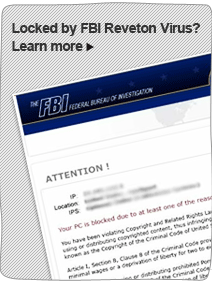I got a Windows Antivirus Master pop up on my PC that I can’t get rid of. I updated a program on the system a couple days ago and this might have brought this program in without my consent. Now every time I turn on the machine, this program will become activated on its own and block most of my operations on the PC. I tried to uninstall it from Control Panel but failed. Is this some kind of malicious software? I don’t want it on my PC. How do I uninstall it successfully? Please help.
Windows Antivirus Master Virus – How to Uninstall Rogue
Windows Antivirus Master pop up is categorized as a rogue software that’s been released recently to mainly attack Windows users around the world. By automatically popping up on a PC and claiming itself as a helpful PC protection tool, the rogue is trying to scam average computer users via creating lots of chaos on the system. Although it looks like a legit program, the rogue is actually nasty and unwanted by many according to records. Windows users are warned, whenever seeing this fake antivirus pop up on the PC, that the program is designed to create chaos which may ask you to pay for its “registered” version in the end in order to deliver “better services”. The rogue pop up, instead of protecting your PC and removing threats, is believed to help online third party to extort money from innocent computer users. Never pay for unknown programs, especially when they are installed automatically without your permission.
Read the rest of this post »
Published by Tony Shepherd on February 7, 2014 4:13 pm and last modified on February 9, 2014 12:30 am.
I got a warning from my anti-virus program and it is about TSPY_ZBOT.PN infection. I know my computer must be infected by this Trojan, and I want it off my computer. But unfortunately, my protection tool did nothing for me. Every time I used the tool to finish the removal, and after the restart, it comes back! This thing drives me crazy! How can I remove it completely? Please advise.
Brief Introduction to This Trojan
TSPY_ZBOT.PN is a horrible Trojan which can attack vulnerable computers all over the world. This infection can be spread from the Internet. Cyber hackers who make this Trojan can implant it into some dubious web pages, especially some adult websites or unknown links. When unwitting people come to those malicious sites, their computer can be infected immediately. Also, those crooks can put this Trojan into other free programs which can be used for computer users. Generally, many free software for people to download from the Internet contain virus or Trojan more or less as hackers always use them to transmit those vicious stuff. Unknown E-mail attachment and peer to peer share are also the methods that hackers use to spread this TSPY_ZBOT.PN Trojan. Read the rest of this post »
Published by Tony Shepherd on February 7, 2014 5:53 am
Can Trojan Horse Dropper.Generic9.SLV be removed by anti-virus software? I keep getting a report from my security program saying my PC is infected by this Trojan but it can’t delete it successfully. Each time it said it did, the Trojan would reappear after a system reboot. What do I do to get rid of the Trojan virus completely? Will it affect my internet connection if I turn off the machine? What is the best way to remove this Trojan virus?
Trojan Horse Dropper.Generic9.SLV – Remove Trojan Infection
Trojan Horse Dropper.Generic9.SLV is a type of Trojan infection that comes from the Dropper group. This Trojan virus can automatically start unknown downloads once installed on a computer. It acts more like a key for many potential malware and ransomware to our computers. But complaints from lots of computer users have shown that this type of Trojan infection cannot be removed by many anti-virus applications. Hence, victims of this Trojan threat are having constant difficulties when running on the infected PCs, especially after the infection has dramatically slowed down the computers. It is also believed that remote hackers may be able to hack into a computer via this Trojan. If you are currently experiencing this Trojan virus pop up on your PC, remove it immediately to avoid further consequences.
Read the rest of this post »
Published by Tony Shepherd on February 6, 2014 10:04 am
I have the websearch.webisgreat.info domain pop up on my browser and I need help to get rid of it. This problem has bugged me for the last couple days. Every time I try to start an online search, I keep being blocked by this pop up. I also get many pop-up ads all over the webs telling me I should install something that I don’t know of. My browser is a complete mess now. How do I fix this?
Websearch.webisgreat.info Redirect – How to Remove?
Websearch.webisgreat.info is categorized as an adware domain that’s designed by online third-party to scam net users on Internet Explorer, Mozilla Firefox and Google Chrome. The pop up domain looks like a simple search webpage that gives shortcuts to resources online. But it is a hijacker which will compromise your browsers once installed by resetting the browser defaults without consent. This browser hijacker is dangerous because it’s able to collect your browsing histories via third-party tracking cookies. Private online data stored in these browsing histories can then be used by cyber criminals. Other than that, the hijacker can also cause lots of disorders on your browsers. Based on that, you are suggested to get rid of the pop up adware as soon as possible to restore browsers.
Read the rest of this post »
Published by Tony Shepherd on February 6, 2014 8:02 am
Windows Efficiency Master popped up on my computer automatically soon as the system launched. It ran scans on the computer and claimed that threats had been found in the computer. Is it a fake antivirus alert or a real one? Can I sign up and activate its full edition to get full protection as suggested? If not, what should I do? How to uninstall this rogue program from the computer without making any damage? If you have failed in deleting the fake antivirus, please follow removal guide below to deal with it effectively.
Brief Introduction to This Windows Efficiency Master Virus
Windows Efficiency Master is categorized as a fake anti-spyware which pretends to help users clean out computer threats. Soon as the rogue program affects the computer, it will pop up automatically every time the system starts. It pops up and covers most part of the computer screen, which blocks users from accessing any other program. Also, users may find it difficult to close or exit this fake antivirus via its pop-up fake alert screen. To make users’ convinced, cyber hackers have created this rogue program to perform as real antivirus which runs automatic scan through the whole system. After the scan, the bogus antivirus displays false and fraudulent scan results telling that your computer is at great risk, as many harmful threats have been detected in the computer. This fake anti-spyware shares the same features as another rogue program Windows Safety Master that makes great damages to the target computer. Consequently, PC users should take actions to uninstall this risky rogue program from the computer completely soon.
Read the rest of this post »
Published by Tony Shepherd on February 6, 2014 4:33 am and last modified on April 10, 2014 4:06 am.
Malwarebytes detected PUP.Optional.EazelBar.A the other day on my computer. What is this threat? It keeps failing to remove the detection successfully. Is this some kind of dangerous virus? Will it damage my PC if I wait? How can I get rid of this PUP alert on my computer? I’m not a tech, please advise.
PUP.Optional.EazelBar.A – Remove Malwarebytes Detection
PUP.Optional.EazelBar.A is a detection that can be detected by Malwarebytes on computers lately. Records have shown that this infection cannot be deleted by the anti-malware program and it’s causing many troubles on the computer, especially browser problems. This PUP infection, short for potentially unwanted program, is believed to be specifically related to a browser hijacker called En.eazel.com redirect which was found to attack browsers a couple months ago. This new detection could be used to distribute this browser hijacker again to attack Internet Explorer, Google Chrome and Mozilla Firefox and steal users’ online personal data for illegitimate purposes. The PUP detection, therefore, can be categorized as an adware that contains unwanted programs and other unfriendly objectives. It can also be treated as a Trojan due to its ability to spread potential malware problems.
Read the rest of this post »
Published by Tony Shepherd on February 5, 2014 3:00 am
Can’t get rid of the http://rapid-searcher.com/ pop up website on browser? Are you having troubles to surf online lately because of this pop up domain on your home page? Do you also encounter constant redirect actions while trying to get online? This specific webpage is an adware domain and you should try to get rid of it ASAP. This passage contains a removal guide with basic steps to help you remove the adware on your browser.
Rapid-searcher.com Redirect – How to Remove?
Rapid-searcher.com is categorized as a browser adware which can attack the most popular browsers on both Windows and Mac OS including Internet Explorer, Google Chrome and Mozilla Firefox. It is not detectable as a computer threat by many anti-malware programs as complaints have shown. But this pop up page should be uninstalled from your browser as it can cause lots of unpleasant experiences and potential malware or spyware problems. It is as risky as other computer threats and is specifically used by online third-party to conduct cyber criminals. For the adware is able to collect your browsing histories and steal online personal data, users who have got this problem on their browsers may end up as victims to unknown financial problems.
Read the rest of this post »
Published by Tony Shepherd on February 5, 2014 1:46 am
My anti-virus cannot help me get rid of this JS:Iframe-DHY[Trj]. I have tried to use my protection tool to remove it for many times. But it is still in my computer. How can I permanently remove it from my computer? I’m not a computer savvy, I don’t know which file belongs to this virus, I’m afraid that I can’t do it by my own. Can somebody help?
Brief Introduction to This Trojan
JS:Iframe-DHY[Trj] belongs to Trojan infection which is one of the largest computer threats families. As a Trojan infection, many legit computer anti-virus programs can detect this for the computer user. However, this pesky Trojan is not easy for those tools to remove. Trojan infection has many specific methods to spread. Once a vulnerable computer is connected to the Internet, then the risk of being infected by many computer viruses or Trojans can be tremendous. Many dubious websites contains different kinds of computer viruses, once some people come to those web pages, computer threats can infiltrate into their computers without their consent. Also, large amounts of free software are used by cyber hackers to disseminate viruses or other computer threats. Once people have downloaded them into their computers and finish the installation, those malicious things can start to harm the computers right away. E-mail attachments, videos, music and other forms are also the ways to be used for Trojans to spread. Read the rest of this post »
Published by Tony Shepherd on February 4, 2014 1:24 pm
Why my browser homepage and the search engine have been changed into this 16Start.com? Every time I open my browser, I get this domain instead. And to my surprise, I can’t change it back to my normal homepage from the browser setting. Is there something wrong with my computer or my browser? Is it a virus? But my anti-virus tells me that my computer works fine? What’s the problem?
Brief Introduction to This Domain
Once this 16Start.com has become the homepage of your browser, you need to be cautious. That means your computer is infected by a malicious browser hijacker which can bring a lot of troubles to your computer. Once you come to this domain accidentally, you will be shown a pop-up box ask you to allow this domain become your homepage, this is a common way for this browser hijacker to invade. People who are not computer savvy can be easily misled to allow this domain becomes their homepages. Once they choose “Yes” option, this redirect infection can take effect in the computer immediately. Also, cyber criminals can bundle this browser hijacker with other free software on the web, once people download those software into their computer, during the install process, this 16Start.com hijacker can pretend as an optional program which can be installed at the same time. Read the rest of this post »
Published by Tony Shepherd on February 4, 2014 12:02 pm and last modified on February 4, 2014 12:10 pm.
For the past few days, I keep experiencing constant redirects to this Snappyimage.surfcanyon.com website. It keeps reappearing on my browser and automatically replaces my home page. I can’t search something online because of the annoying pop ups. Is my computer being hacked by some malware? Why can’t my security program pick up the threats? What steps should I take to get rid of the pop ups to restore my browser?
Snappyimage.surfcanyon.com – How to Remove?
Snappyimage.surfcanyon.com is categorized as a browser adware domain that’s full of misleading information from unidentified resources on the Internet. By displaying these results to computer users, the adware can scam average computer users and cause constant troubles on the computers. Although the popup is not picked up by anti-malware programs, it is as risky as other computer viruses or malware and should be eliminated completely from a computer via manual removal. If you are currently encountering a continuous change of home page on browsers automatically and constant redirects whenever searching online due to this specific popup, remove the adware as soon as possible to avoid further computer problems including Trojan infections and potential malware threats.
Read the rest of this post »
Published by Tony Shepherd on February 4, 2014 2:21 am










